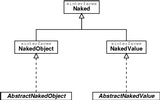Naked Objects
By Richard Pawson and Robert Matthews
The anatomy of a naked object
A Naked Object system is simply a collection of classes that are made
available to the user. To be rendered visible to the user, an object must
be of the type org.nakedobjects.object.Naked. This interface
is defined within the Naked Objects framework along with two
sub-interfaces. The first is
org.nakedobjects.object.NakedValue, for value objects, which
store simple data values (such as text, numbers, currency and dates) and
are only used inside other objects. The framework provides a number of
ready-made classes that implement this interface, several of which we shall
be introducing in this section. Programmers can add new
NakedValue classes if needed. The second sub-interface is
org.nakedobjects.object.NakedObject. This is used for
objects that need to be referenced in multiple contexts, which typically
means your business objects.
The simplest way to ensure that your business objects conform to the
NakedObject definition is to make them sub-classes of
org.nakedobjects.object.AbstractNakedObject - a class
provided by the framework. If you cannot do this, because your business
object must inherit from some other hierarchy, then you will have to
implement the methods required by NakedObject
yourself.
AbstractNakedObject implements all of the methods in
the NakedObject interface except for
title, which we will discuss shortly. Thus it provides
you with a foundation for building your business objects. We will
use this class throughout our discussions.

The Naked class hierarchy |
If a business object class is defined as a subclass of
AbstractNakedObject, then you must also do the following in
order for the framework to be able to access and manipulate these
objects, and thereby make them available to users:
- Declare the class as public.
- Ensure the class has a zero-parameter constructor (this is often referred to as the default constructor).
- Declare as public all of its methods that are to be made available to the framework.
- Implement the abstract
titlemethod from the superclass so that it returns a non-null reference. Thetitlemethod will help users to distinguish each object from the rest of the instances of a specific type - but it could also be used for other purposes, such as searching or report generation.
Copyright (c) 2002 nakedobjects.org You may print this document for your own personal use, or you may copy it in electronic form for access within your organisation, provided this notice is preserved.